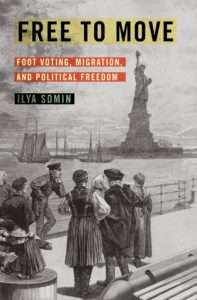[1.] In Altman v. County of Santa Clara (N.D. Cal.) (Jon Tigar, J.), decided a week ago, the court basically concluded that the Santa Clara County lockdown of “non-essential businesses,” which included gun stores, didn’t violate the Second Amendment, in large party because it was just a “waiting period”:
[T]he Order is not the equivalent of the handgun ban in Heller[, but] … effectively bans most residents of Alameda County from purchasing handguns for the limited duration of the Order. Plaintiffs argue that the Court should treat the ban as permanent given that the latest Order “ha[s] no end date and can be renewed and revised infinitum per [its] own terms.” But Alameda County’s May 18 Order imposes clear and well-defined criteria for its termination, requiring the County’s health officer to “continually review whether modifications to the Order are warranted” based on progress on certain enumerated, empirical “COVID-19 Indicators” [and modifications have indeed been made] …. The same reasoning leads the Court to conclude that the Order does not effect a “plain, palpable invasion” of Plaintiffs’ Second Amendment rights [the test suggested for epidemic emergencies by Jacobson v. Massachusetts (1905)].
The court also noted that, “the Order, … unlike the handgun ban in Heller, is facially neutral” rather than singling out gun stores for special restrictions. Partly because of these factors, the court concluded that the order should be evaluated only “intermediate scrutiny,” which the Order passed:
Intermediate scrutiny is a two-step test that requires “(1) the government’s stated objective to be significant, substantial, or important; and (2) a reasonable fit between the challenged regulation and the asserted objective.” “[I]ntermediate scrutiny does not require the least restrictive means of furthering a given end.” The government must “show only that the regulation ‘promotes a substantial government interest that would be achieved less effectively absent the regulation.'” “The test is not a strict one,” but “requires only that the law be ‘substantially related to the important government interest ….'”
The stated objective of the Orders is “to slow the spread of COVID-19.” Defendants’ second stated objective—conserving health care resources—follows naturally from this first goal….
As for fit, every resident of Alameda County is a potential vector for COVID-19. Defendants have produced evidence that any decrease in human contact and in-person interaction helps slow the virus’s spread, and thus that any exception to the shelter-in-place order makes the order less effective at achieving its goal. This evidence forecloses Plaintiffs’ argument that allowing firearms and ammunition retailers to operate under social distancing and sanitation guidelines would constitute a less restrictive alternative that would further Defendants’ goals. According to the evidence Defendants have submitted, adding these retailers to the list of essential businesses exempted from the Order would “increase[] the risks of community transmission” even when social distancing protocols are followed, as those protocols “lower[] but do[] not eliminate the increased transmission risks.” And even if this alternative did further the County’s goals, “intermediate scrutiny does not require the least restrictive means of furthering a given end.”
Plaintiffs further argue that the Order “inconsistently pursues” Defendants’ goals because it is “so pierced by exemptions and inconsistencies that [they] cannot hope to exonerate [it].” … [But] Defendants here have offered a “convincing reason” for exempting the essential businesses enumerated in the Orders. See ECF No. 46-7 ¶ 11 (explaining that exempted businesses “such as grocery stores, pharmacies, laundromats/dry cleaners, and hardware stores are deemed essential because they provide for the basic needs of residents for food, medicine, hygiene, and shelter. If people have no opportunity to wash their clothes, they can get fleas and ticks, which can spread other infectious diseases, such as flea-borne (murine) typhus and trench fever. And hardware stores provide supplies needed to maintain shelter, such as heat, indoor plumbing, and refrigeration, that will require maintenance and repair to keep them working.”). Perhaps a different governmental entity could conclude that firearms and ammunition retailers and shooting ranges are essential, and some have. [But] the efficacy of the Order is not “undermine[d]” or “counteract[ed]” by the exclusion of firearms and ammunition retailers from the list….
[2.] On the other hand, the Connecticut decision posted today (Connecticut Citizens Defense League v. Lamont (D. Conn.) (Jeffrey Alker Meyer, J.), issued a preliminary injunction against a Connecticut policy that effectively blocked many gun purchases:
In Connecticut, you cannot acquire, possess, or carry a handgun without a state permit or certificate. To get a permit or certificate, you must go to the local police or the Connecticut Department of Emergency Services and Public Protection (“DESPP”) to have an officer there collect your fingerprints for purposes of a criminal background check.
Under Connecticut law, employees for the local police and DESPP may not refuse to collect the fingerprints of a person who seeks to apply for a handgun permit or certificate. In light of the exigencies of the COVID-19 pandemic, however, the Governor of Connecticut issued an executive order nearly three months ago that indefinitely suspends this law for so long as the COVID-19 emergency may continue. The executive order leaves it to the discretion of state and local police whether to conduct fingerprinting, thus empowering the police to functionally deny the right of new applicants to acquire, carry, and possess a handgun. Consistent with the Governor’s order, DESPP and some unknown number of police departments have suspended all fingerprint collection activities that the law used to require them to do….
The Governor’s Executive Order No. 7E and the Commissioner’s implementation of the order plainly burden conduct protected by the Second Amendment. Because these actions result in the suspension of fingerprinting while not suspending the statutes that make fingerprinting necessary to issuance of a handgun permit or certificate, they categorically foreclose a person who does not already have a permit or certification from acquiring a handgun if the person’s fingerprints are not already on file. One cannot exercise the right to possess a handgun in the home for self-defense if one is prevented from acquiring a handgun in the first place….
The court rejected the “temporary delay” argument (explicitly as to the question whether plaintiffs have standing to challenge the policy, and implicitly as to the constitutionality of the policy):
Nor is there any merit to the arguments of the Governor and the Commissioner that a “temporary delay” occasioned by the suspension of fingerprinting does not result in injury. If the Governor and the Commissioner were to issue a gag order barring plaintiffs from exercising their First Amendment free speech rights for the balance of the COVID-19 crisis, plaintiffs would surely suffer injury despite the “temporary” nature of the crisis. The same holds true for plaintiffs’ exercise of their Second Amendment rights.
And the court concluded that the policy would fail intermediate scrutiny:
I need not choose between whether intermediate or strict scrutiny applies here, because the indefinite suspension of fingerprinting that is essential to the issuance of a pistol permit does not meet even the lower standard of intermediate scrutiny.
To withstand intermediate scrutiny, a law must generally be “substantially related to the achievement of an important governmental interest.” The “fit” between the challenged action and the governmental interest need not be “perfect” but must be “substantial” with “reasonable inferences based on substantial evidence.” Thus, in a case “implicating the core of the Second Amendment right,” the Seventh Circuit has applied intermediate scrutiny to require a municipality to “establish a close fit between the [firing] range ban and the actual public interests it serves, and also that the public’s interests are strong enough to justify so substantial an encumbrance on individual Second Amendment rights.”
To begin, there is no doubt that the Governor and the Commissioner have a compellingly important government interest: protection of law enforcement personnel, permit applicants, and Connecticut residents generally from infection by the COVID-19 virus…. Still, as the Supreme Court recognized in Jacobson v. Massachusetts, the courts retain a role to examine the use of governmental power even during a public health emergency, for “an acknowledged power of a local community to protect itself against an epidemic threatening the safety of all might be exercised in particular circumstances and in reference to particular persons in such an arbitrary, unreasonable manner, or might go so far beyond what was reasonably required for the safety of the public, as to authorize or compel the courts to interfere for the protection of such persons.”
In other words, just as “a state of war is not a blank check for the President when it comes to the rights of the Nation’s citizens,” Hamdi v. Rumsfeld, 542 U.S. 507, 536 (2004), the COVID-19 crisis does not mean that government officials have limitless discretion to intrude on the rights of the people. Nevertheless, courts owe great deference to the protective measures ordered by government officials in response to the COVID-19 crisis, not simply because the virus has lethal consequences but also because the virus acts in unknown ways that engender uncertainty about what scope of protective measures are warranted. See S. Bay United Pentecostal Church v. Newsom, — S.Ct. —, 2020 WL 2813056 (2020) (Roberts, C.J., concurring) (discussing the need for deferential judicial review of COVID-19 protection measures).
Even granting these principles of deference and even granting the wisdom of the decisions of the Governor and the Commissioner to initially suspend all fingerprinting at the outset of the COVID-19 pandemic, the Governor and the Commissioner have not shown that there continues to be a substantial fit between the goal of protecting people from COVID-19 and a suspension of all fingerprinting collection requirements. The fact that the four police chief defendants have resumed fingerprinting activities and that the Commissioner has stated his intent for DESPP to resume fingerprinting activities on June 15 is powerful evidence that the ongoing suspension of fingerprinting has become needlessly overbroad—that it does not continue to be a reasonable and substantial fit to the necessity of protecting public health in light of alternative and available protective measures for the police to use when collecting an applicant’s fingerprints.
Indeed, the Commissioner himself in one of his affidavits lists available protective measures that would be less overbroad than a shutdown of the permitting process. Doc. #58-17 at 4-5 (¶ 24) (scheduled appointments, limited hours and days of operation, temperature checks, plexi-glass barriers, social distancing between waiting applicants, use of masks and protective personal equipment, and sanitization between uses of equipment). These are the types of protective measures that have already been approved by the Governor and put into operation across broad sectors of the state economy, including even for business activities involving close and extended personal interaction such as at hair salons and barbershops. What is expected from a barber or hair stylist is not too much to expect from a police officer in the service of allowing the people to exercise their constitutional rights. The police continue to routinely collect fingerprints from arrestees, and there is no showing why collecting fingerprints from those who seek to exercise their constitutional rights is categorically too hazardous to allow for the indefinite future.
The U.S. Constitution permits the States to set out a procedural road to lawful handgun ownership, rather than simply allowing anyone to acquire and carry a gun. See Kachalsky v. Cty. of Westchester, 701 F.3d 81, 98 (2d Cir. 2012). That road may be long. See Silvester v. Harris, 843 F.3d 816, 828 (9th Cir. 2016) (upholding waiting period). It may be narrow. See Jimenez, 895 F.3d 237 (upholding ban on firearm possession by persons dishonorably discharged from the military for felony-equivalent conduct). It may even have tolls. See Kwong v. Bloomberg, 723 F.3d 160, 167-69 (2d Cir. 2013) (upholding handgun licensing fee). But it may not be built only to be indefinitely closed down when there are evident alternatives to achieve the government’s countervailing compelling interest.
That is what has happened here by means of suspending the requirement that the police collect an applicant’s fingerprints while still demanding such fingerprints for approval of a handgun permit. Plaintiffs have shown a clear and substantial likelihood of success on the merits of their Second Amendment claim.
from Latest – Reason.com https://ift.tt/2XOiVmo
via IFTTT



